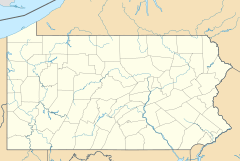Shavertown, Pennsylvania facts for kids
Quick facts for kids
Shavertown, Pennsylvania
|
|
|---|---|
| Country | United States |
| State | Pennsylvania |
| County | Luzerne |
| Township | Kingston |
| Area | |
| • Total | 1.2 sq mi (3.2 km2) |
| • Land | 1.2 sq mi (3.2 km2) |
| • Water | 0 sq mi (0 km2) |
| Population
(2010)
|
|
| • Total | 2,019 |
| • Density | 1,634/sq mi (631/km2) |
| Time zone | UTC-5 (Eastern (EST)) |
| • Summer (DST) | UTC-4 (EDT) |
| ZIP code |
18708
|
| Area code(s) | 570 |
Shavertown is a small community located in Kingston Township, Luzerne County, Pennsylvania, United States. It is known as a census-designated place (CDP). This means it's a special area identified by the U.S. Census Bureau for collecting population data.
Shavertown is about 7 miles (11 km) northwest of Wilkes-Barre. It is also about 24 miles (39 km) southwest of Scranton. In 2010, the population of Shavertown was 2,019 people.
Contents
History of Shavertown
Shavertown gets its name from an early settler named Philip Shaver. He was a very important person in the area's history.
Philip Shaver's Land Purchases
In 1813, Philip Shaver bought a large piece of land. He purchased it from William Trucks, who gave his name to the nearby town of Trucksville. This land was 1,400 acres, which is a huge area! Philip believed that buying land was a good investment.
Later in 1813, Philip sold a part of his land to John McClellon. A small village called McClellonsville was built on this land. It was later renamed Dallas. By 1818, Philip still owned almost a thousand acres in the "Back Mountain" area.
Philip Shaver's Early Life
Philip Shaver was born in 1762 in Vienna, Austria, near the Danube River. He moved to the United States with his family between 1765 and 1769.
On December 12, 1786, Philip married Mary Ann Wickizer. They had seven children together. Their children were John Philip, Peter, William G., Elizabeth, James Henry, George, and Asa W. Shaver.
Around 1804, Philip and his family lived in Forty Fort. They stayed there until 1810 before moving to the Back Mountain area.
Developing the Back Mountain Area
Philip came to the "Back of the Mountain" looking for very tall evergreen trees. He had to create a path through thick forests. This path is now known as Route 309.
In 1815, Philip and his sons built a sawmill. This first mill was on the north branch of Toby Creek. It was located near the Prince of Peace Church in Dallas.
Philip also helped with other big projects. In 1820, he cut the wood for the first Market Street Bridge in Wilkes-Barre.
Philip Shaver's Legacy
Philip Shaver wanted to help his community grow. He believed everyone should have chances to learn. After seeing children working on farms, he wanted them to learn to read and write.
In 1816, Philip donated land for the first school in the Back Mountain. This school was a simple one-room log cabin. Today, the Back Mountain Memorial Library stands on that same spot.
Philip also set aside land for a public cemetery. This burial ground was on a hill south of Dallas Village. He also chose a special plot for his own family's graves.
Philip Shaver's Final Years
In November 1826, Philip Shaver had a serious accident. His hand was badly injured while he and his sons were using a cider press. Sadly, he passed away a few days later on November 7, 1826, due to complications from the injury.
Philip's headstone is at the end of the Shaver Cemetery. It looks out over the graves of his family. His footstone has a special message that shows his many travels: "Here lies my weary feet." Even though he was a serious man, Philip was also known for his sense of humor.
See also
 In Spanish: Shavertown (Pensilvania) para niños
In Spanish: Shavertown (Pensilvania) para niños



